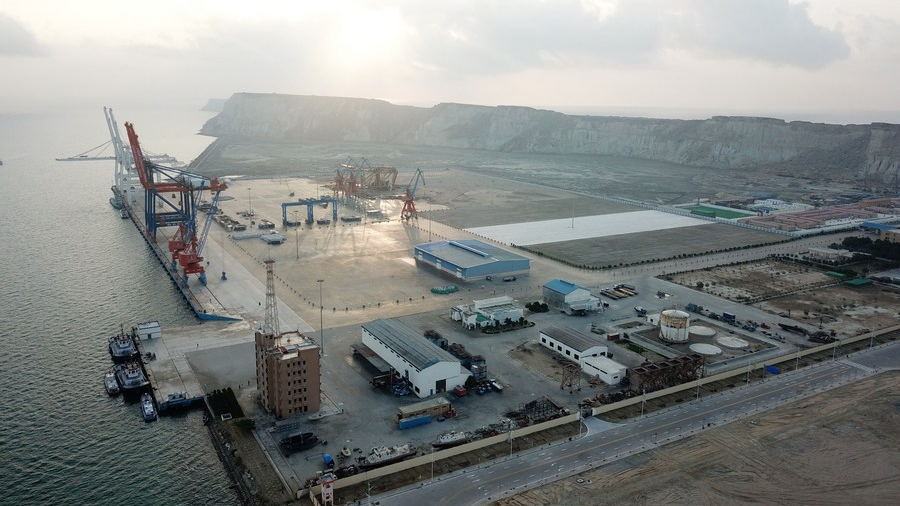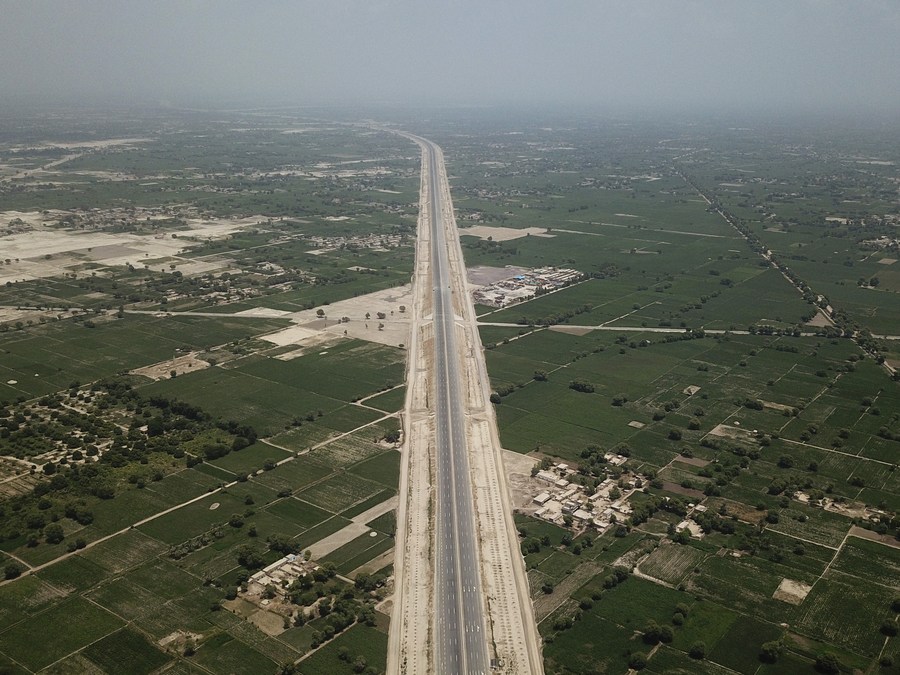
A view of Gwadar Port in southwest Pakistan's Gwadar, January 29, 2018. /Xinhua
A view of Gwadar Port in southwest Pakistan's Gwadar, January 29, 2018. /Xinhua
Editor's note: The article was first published on the Muslim World Research Center website. Dr. Junaid S. Ahmad is the Director of the Center for Muslim World Studies and teaches Religion and Global Politics in Islamabad, Pakistan. Osama Rizvi is an economic, geopolitical and energy market analyst with special focus on Eurasia and China. The article reflects the authors' opinions and not necessarily the views of CGTN.
It is no surprise to anyone, it shouldn't be, that China's ascension in economic and diplomatic is now at its peak. With a $24 trillion economy, when measured through Purchasing Power Parity (a measure endorsed by both CIA and IMF), a burgeoning middle class and a sprawling closely knit network, of both maritime and land, countries, China is set on its course to play a prominent, significant and positive role on the global level. This mantle and position, which is not new for the country, brings with it many challenges and much more opportunities. As Dr. Parag Khana remarks the "Future is Asian" - and if that is true then China is the leader of that future. Peter Frankopan puts it beautifully and succinctly, in The New Silk Roads, "All roads used to lead to Rome. Today, they lead to Beijing." He cannot be more correct.
There is a plethora of examples to gauge and see China's resilience. But what better example is out there than the one of her response to one of the most formidable nemesis, a force of nature, of course, COVID-19. A country which was hit severely by this enigmatic virus and the way they fought and then overcame is nothing less than exemplary. From building new hospitals in few days, to the meticulous discipline showcased by the people, and from avoiding a recession - as predicted by many - to instead register economic growth when the whole world seems to be mired in a downward economic spiral, China has defeated the virus.
Chinese GDP grew by 6.5 percent in the fourth quarter (Q4) of 2020 beating most of the estimates. The improvement is also reflected in trade figures as exports grew by 9.9 percent and imports at 13.2 percent. Not only this but according to a report by Mckinsey domestic travel is reaching pre-pandemic levels with number of flights and occupancy rates of hotels regaining almost 90 percent of 2019 levels.
The most important development - as we point out at the beginning -that merits more discussion and attention than is being given, is the fact that according to Purchasing Power Parity – one of the yardsticks to measure GDP (other one being Market Exchange Rate) – China's economy is now one-sixth larger than that of the U.S. i.e $24 trillion vs. $20 trillion. This PPP has been endorsed by both IMF and CIA as being a better indicator to measure growth than MER. Also, in an ironic development when juxtaposed with the on-going economic scrum between two largest economies , China's first ever bond offering to the U.S. was a huge success with a whopping $27 billion of orders by U.S. investors.
With more than a 30 times rise in income on per capita basis and adding 10 years in life expectancy (since 1984), the country continues to offer a hundred reasons for one to learn and be amazed. Compared to 1 percent in 2015, foreigners can now access 60 percent of its market, the fundamentals there remain strong (if you don't believe me, then you may do so when Ray Diallo says it).

Aerial view of Sukkur-Multan Motorway in central Pakistan's Multan, August 5, 2019. /Xinhua
Aerial view of Sukkur-Multan Motorway in central Pakistan's Multan, August 5, 2019. /Xinhua
As the world global business seems to be wrapped in technological changes, China is not behind at this front as well. It's R&D spending is second only to the U.S. and as Council of Foreign Relations - a U.S. think tank observed, in fifth generation telecommunication, biotechnology and other sectors China is at par with that of the U.S. The same is true for the Renewables. China’s investment beats all other countries in that regard. China is leading from the front in AI, EV and 5G, many will be surprised to know that by 2025 there will be 1.2 billion users of 5G and a third i.e. 400 million are expected to be from China alone.
After 25 years of wait, China has finally started trading Yuan oil futures. Yes, it challenges the dominance of the dollar, as most of the world's commodity trade is carried in US dollars. With China interested in buying a major stake in the impending Aramco IPO, one can be hopeful that Saudi Arabia also accepts Yuan oil futures. One can relate the Belt and Road Initiative (BRI) to this growing eagerness to use Yuan for trade.
As of today, if we are to bet on potential, China qualifies as a first option. It is growing and strengthening its economic and political influence. We shouldn't be surprised that after China is done with integrating the Eurasian landmass the Pax Sinica will reign supreme.
What does this mean for the world? And especially the Muslim world? More than what these countries could imagine. The BRI, a project of unprecedented scale - seven times bigger than the Marshall Plan that helped built post-war Europe - will connect a huge number of countries via land and sea routes. With access to the world's largest market, trade and therefore diplomatic relations will only grow with the country. This year China finalized what is called the Regional Comprehensive Economic Partnership (RCEP) - it contains more than dozen countries from Asia Pacific Region with about 2.2 billion people (30 percent of the world's population) with a combined GDP of $26 trillion accounting for 28 percent of world trade. The sheer scale and scope of this project shows how China is preparing for future and that her relevance is only bound to increase.
The rapid rise of China described above represents far more than the very modern notion of the nation-state. Indeed, as Martin Jacques states, China is a civilization-state. Unlike other "great powers" in world history, none have risen and risen again like Chinese civilization. Indeed, the developments taking place now are the proper re-orientation of the global order to its proper historical direction.
In this light, a parallel "renaissance" or resuscitation has occurred in the Muslim world. In a similar vein to the condition of China from the 19th century to the middle of the 20th, the Muslim world experienced the brunt of colonial subjugation during roughly the same period. However, the process of former political decolonization was at least one step in the right direction. But there was much to be desired because forms of neo-colonialism persisted in large parts of the Muslim world.
Despite the "regime change" operations the deaths and refugees over the past two decades, the Muslim world is finally beginning to recover its own traditional role in a historical trajectory where its civilization played a significant role in world affairs. Muslim world civilization intersected quite harmoniously with its neighbor, Chinese civilization. Indeed, the old "Silk routes" were used cooperatively by Chinese and Muslim traders alike.
In the present juncture, it is perfectly sensible for a Sino-Muslim World cooperative compact, in addition to a power like Russia, continue and sustain the prosperous and more just and equitable "alternative modernity" that China has been leading now for many years. Nations such as Pakistan and Turkey which in the past were trapped by old Cold War entanglements are now asserting genuine sovereignty and independence. These nations are also keenly aware of the re-ordering of global geopolitics.
The Pakistan-China axis, in particular, is the route through which a genuine Sino-Muslim world partnership can be forged. If we see China as a civilization-state, then Pakistan can be considered a sub-civilization one; a pivot state that can enable trade routes and alliances from Islamabad to Istanbul. It is precisely these new partnerships with the Muslim world that China is forging that presents the way forward for a sustainable and just development for humanity at large.
(If you want to contribute and have specific expertise, please contact us at opinions@cgtn.com.)

